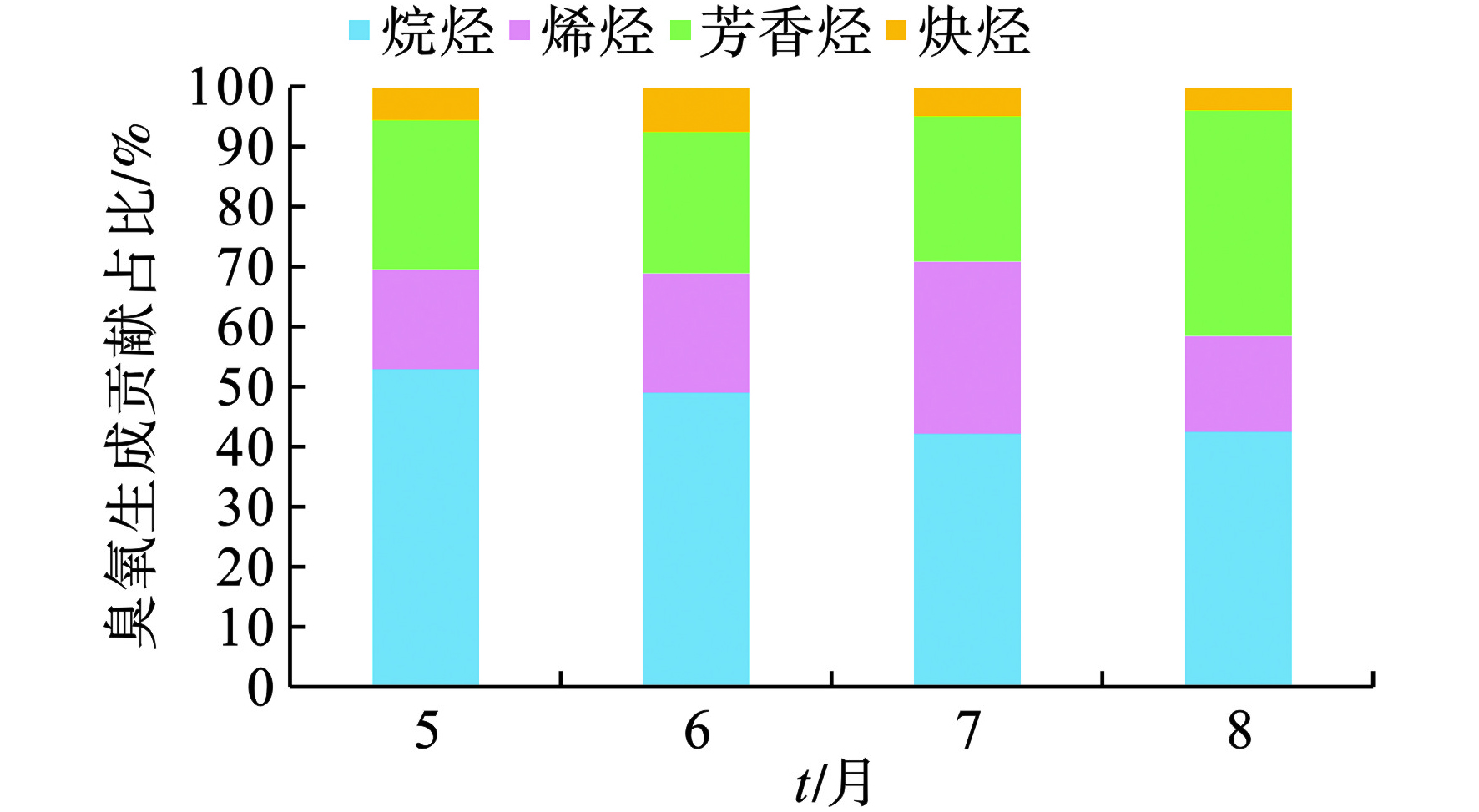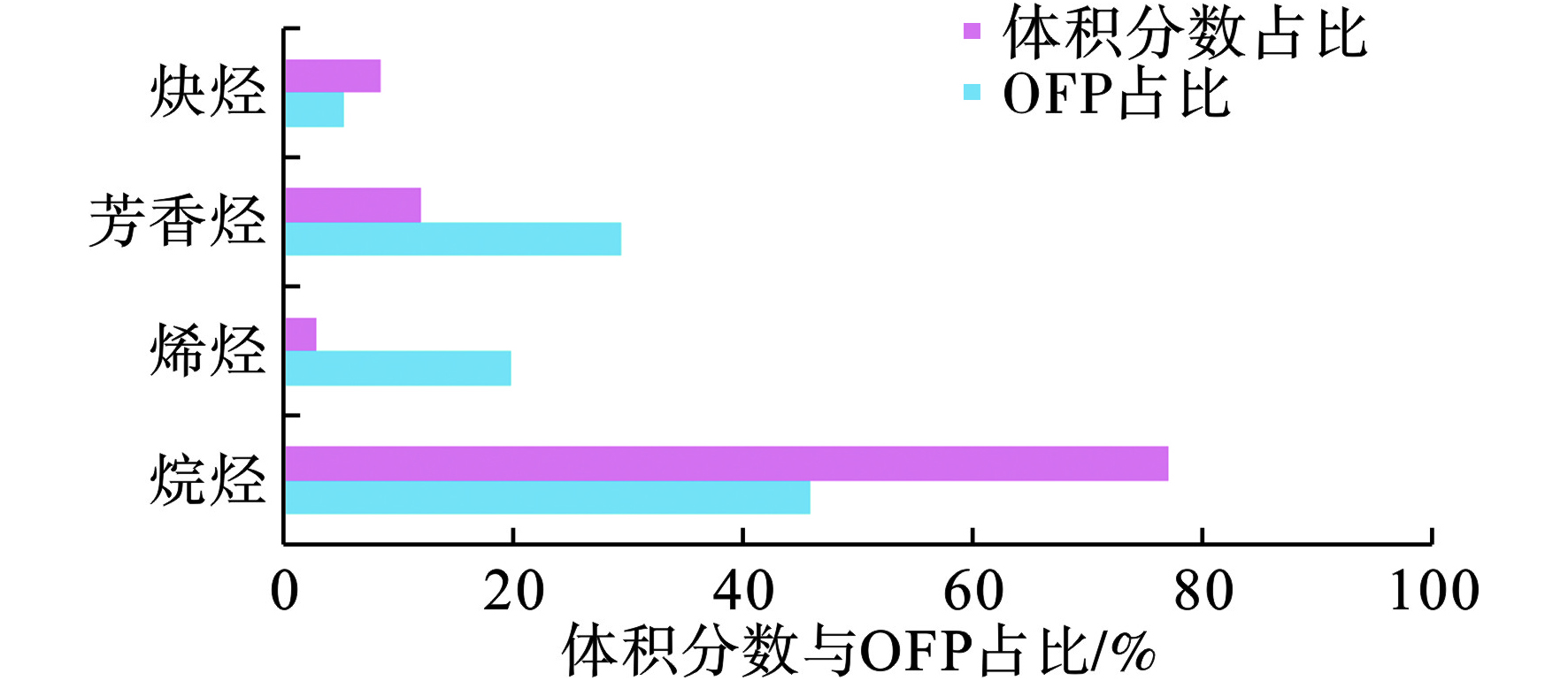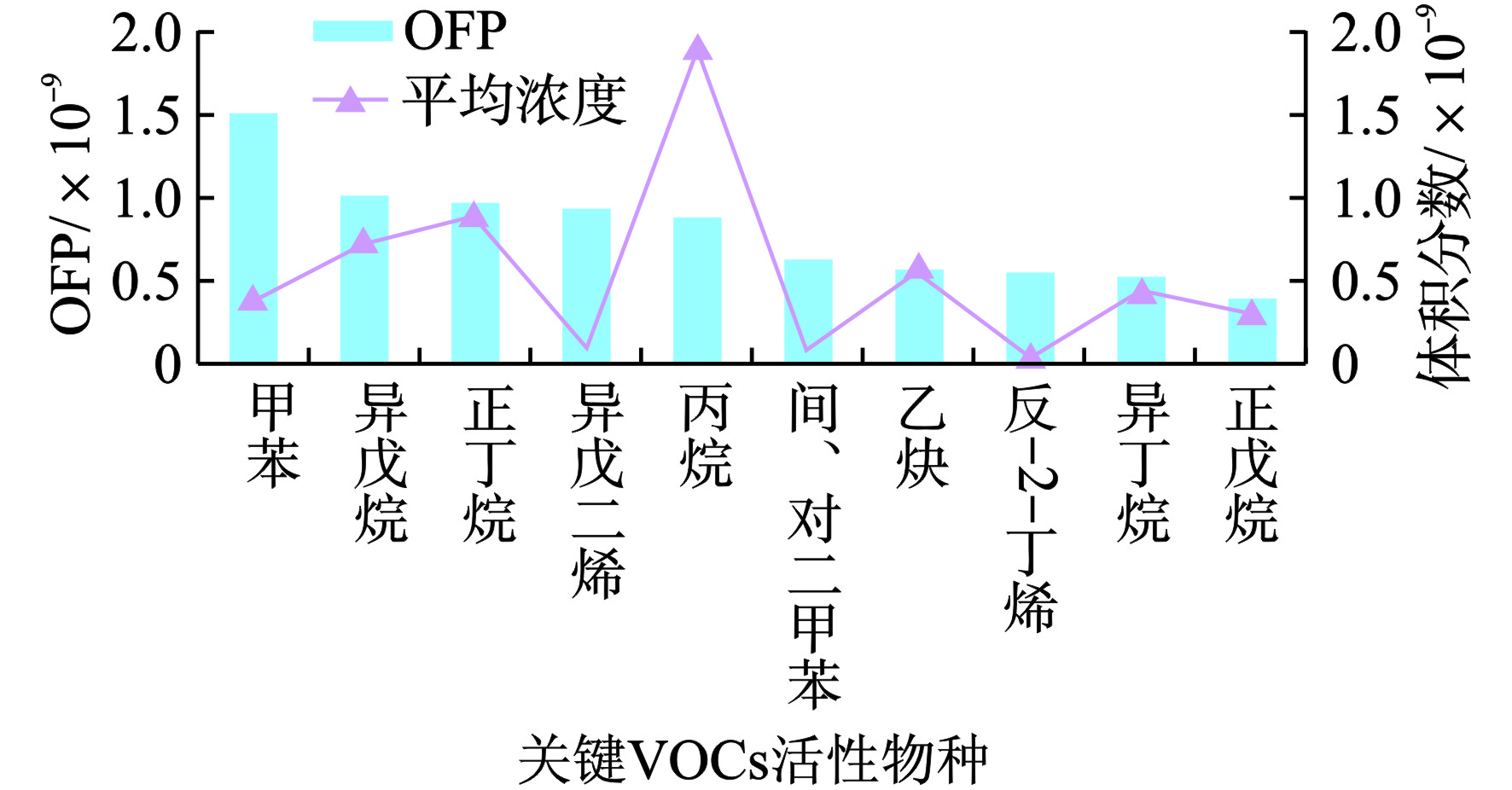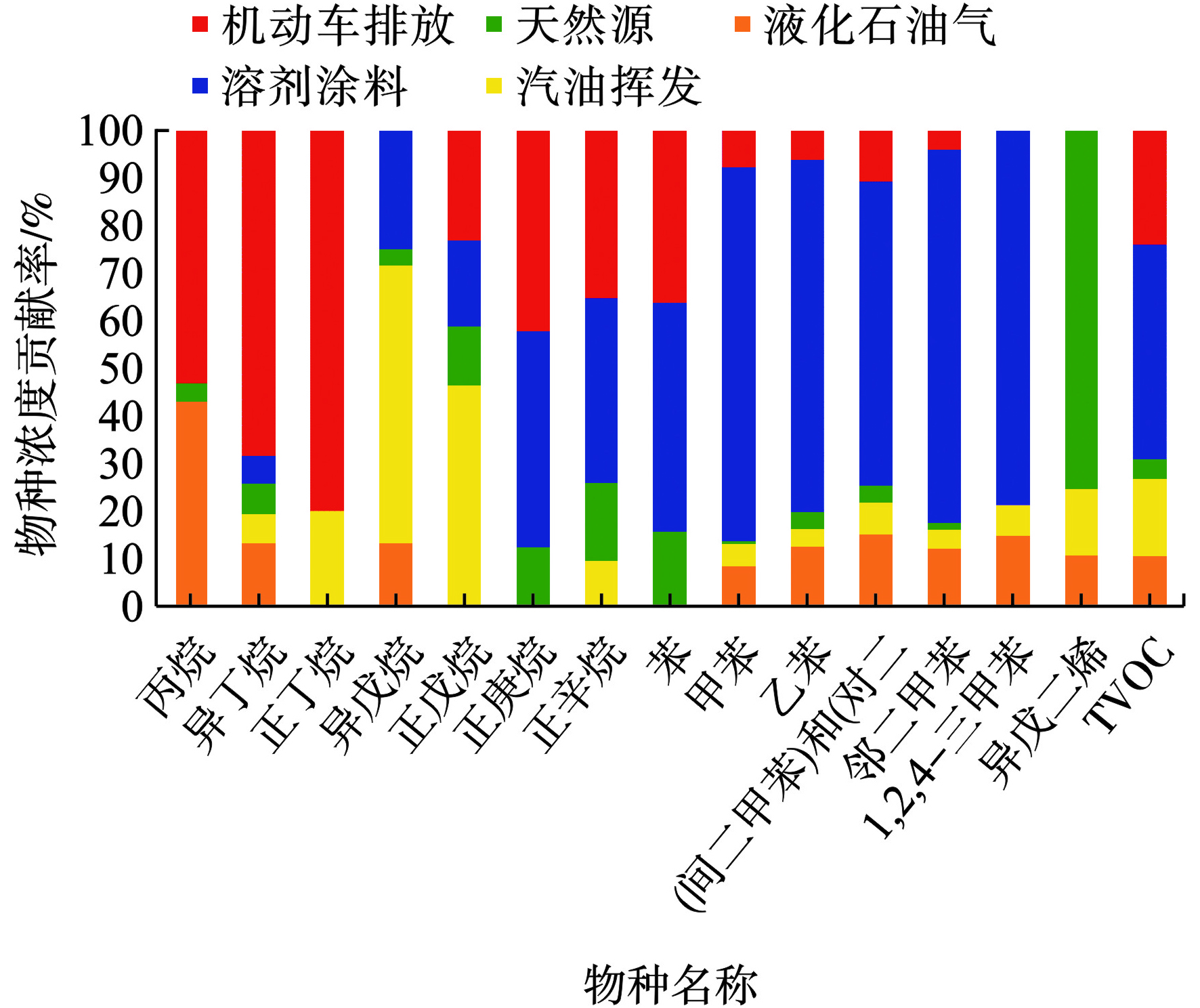-
现代城市中由VOCs引发的污染问题已引起人们广泛关注,不仅会导致O3污染等问题,还对人体健康造成危害。目前,国内学者[1-3]针对O3污染来源、VOCs排放对O3的影响开展了大量研究,但不同城市大气中VOCs的排放来源差异较大,使得各种组分的浓度水平、化学反应活性差别非常大,因此找出城市的关键物种并归溯其来源,才能对症下药,精细化管控。为了解大连市VOCs浓度水平及各物种化学反应活性,找出导致我市夏季臭氧浓度高的活性组分,本研究对大连市区2019年5~8月份大气VOCs的组分及浓度进行了监测,并分析了VOCs月变化特征,对VOCs各物种的化学反应活性进行评估,最终利用PMF模型解析的方法推算出大连市夏季VOCs的污染排放来源及贡献率。
全文HTML
-
大连市地处欧亚大陆东岸,辽东半岛最南端,位于东经120°58′~123°31'、北纬38°43′~40°10′之间,大连属三面环海,属海洋性季风气候,夏季以偏南风为主。夏季为大连市臭氧污染高发季节,近年自5月开始,臭氧持续升高并取代PM2.5成为夏季首要污染物。
本研究针对2019 年夏季臭氧浓度较高月份(5~8月),连续测定大气中VOCs的浓度,设置1个监测点位,位于辽宁省大连生态环境监测中心4层楼顶(东经121°33′49″,北纬38°53′04″),距地面高度大约为15 m,在这个高度上污染物基本混合均匀。该点位毗邻国控点位星海三站,离中山路主干路较近,车流量较密集,周边环境以学校、行政办公、医院和居住区为主,机动车流量等各方面都具有很好的代表性,监测数据可以反映大连市区综合环境质量状况。
-
在本次监测过程中,采用Synspec GC955-611/811臭氧前驱体(VOCs)在线气相色谱仪持续观测环境空气中VOCs,GC955臭氧前驱体分析系统由低碳(C2-C5)分析仪和高碳(C6-C12C)分析仪两套仪器组成。根据VOCs在线监测相关质控规定,为保证数据的有效性,仪器采集率尽可能接近100%,有效性不低于80%,每周使用标准气体对系统校正,保证仪器稳定持续运行,工作人员每日对VOCs数据进行审核,保障数据完整可靠。
-
由芬兰赫尔辛基大学Paatero教授和Tapper于1993年提出的正矩阵因子分解法,是一种被广泛的应用于大气环境中颗粒物及VOCs来源解析研究中[4-7]的多元统计分析方法。本研究应用PMF源解析,在监测出的37种物质中,剔除了无效数据和浓度长期低于检出限的物种,另外一些化学性质活泼的物质也不参与解析,以下为具体物种选择原则及因子数目设定原则,模型解析的不确定度参照文献[8]确定。
-
①浓度较小的物种不纳入计算;②校准相对误差超过允许范围的组分不纳入计算;③大气光化学活性强、大气存留寿命较短的组分不纳入计算;④异常样本、零值多且浓度较低以或偏离平均值严重的VOCs组分均予以删除。
-
PMF分析至少需要4个因子数;在该因子数目下,所有因子都具有实际物理意义,都对应大气中的某一排放源活化学过程。
参数设定及模拟结果如下:
使用EPA PMF5.0版本模型进行源解析,经过多次试验尝试,确定5个因子,物质22种(bad:2,4-二甲基戊烷,反-2-丁烯,正己烷,环己烷、2-甲基戊烷、3-甲基己烷、2,2,4-三甲基戊烷、2,3,4-三甲基戊烷;week:正戊烷)。
1.1. 采样时间和地点
1.2. 样品采集
1.3. PMF源解析方法
1.3.1. 物种选取原则
1.3.2. 因子数目设定原则
-
本研究共检出37种挥发性有机化合物,其中烷烃20种,烯烃8种,芳香烃8种,炔烃1种。大连市夏季VOCs平均体积分数为6.87×10−9,从VOCs组分体积分数来看,烷烃>芳香烃>炔烃>烯烃,分别占总量的77.0%、11.9%、8.4%和2.7%。
各月组分占比略有不同,其中烷烃占比最大(74.7%~80.6%),其次为芳香烃(8.8%~16.0%)、炔烃(6.9%~11.4%)和烯烃(2.0%~4.1%),见图1。
从夏季各月浓度变化情况来看,5月份VOCs平均体积分数最低,为5.59×10−9,主要成分依次为烷烃、芳香烃、炔烃和烯烃;6月、7月平均体积分数略微升高,分别为6.30×10−9和5.90×10−9,各组分体积分数变化较稳定,依然以烷烃为主,其他3种组分浮动变化较小。8月大连市平均气温较5~7月平均温度有所升高,VOCs在高温情况下其挥发性更为活跃,VOCs体积分数升高,为9.71×10−9,其中,烷烃和芳香烃有明显升高,炔烃和烯烃则变化较小。烷烃是大连市城区环境空气中含量最高的VOCs,这些物质主要来自机动车排放及燃料挥发等,与2018年同期相比,各月VOCs体积浓度下降显著,下降幅度分别为63.3%、68.3%、54.2%和65.9%,其中6月降幅最大。
-
大气有机物化学反应活性是指某一有机物通过反应生成产物或者生成臭氧的潜势(OFP),OFP计算方法以CARTER[9]研究给出的最大增量反应活性(max incremental reactivities,MIR)的修正值计算臭氧生成潜势(OFP)。OFP为某VOCs化合物环境体积分数与该VOCs的MIR系数的乘积,计算见式(1)。
式(1)中:
[VOCs]i 表示实际观测中的某VOCs大气环境浓度,单位为×10−9,MIRi 用Carter研究所得的MIR系数。根据OFP的计算结果可知,夏季大连市大气中VOCs平均化学反应活性浓度为10.64×10−9,5月最低,活性浓度为7.35×10−9,8月最高,活性浓度为16.42×10-9。从活性组分来看,烷烃占比最大且月变化较为稳定,其次为芳香烃和烯烃,炔烃占比最低,各类组分占比分别为45.8%、29.3%、19.8%和5.1%。7月份烯烃占比有所升高,8月份则芳香烃占比明显增加,见图2。
各组分体积分数和化学反应活性水平并不完全成正比,由于烯烃较为活泼,在浓度较低的情况下,其活性水平大于炔烃,见图3。
-
监测结果显示,大连市VOCs体积浓度最高的前10种物质占VOCs总体积分数的比例为丙烷>正丁烷>异戊烷>乙炔>异丁烷>甲苯>正戊烷>正己烷>癸烷>苯,累计占VOCs总浓度的86.3%,优势物种为烷烃、芳香烃和炔烃等。
根据OFP计算方法得出,大连市大气中活性浓度最高的前10种物质依次是甲苯>异戊烷>正丁烷>异戊二烯>丙烷>间、对二甲苯>乙炔>反-2-丁烯>异丁烷>正戊烷,累计占VOCs的79.1%。其中排在前三位的甲苯、异戊烷和正丁烷的体积浓度占TVOC的29.3%,各物质浓度与OFP并不完全成正比,关键VOCs活性物种浓度与OFP对比见图4。
-
对筛选出的22种物质,利用PMF模型来进行源解析研究,经过反复尝试最终确定了5类因子。
因子1富含正丁烷、异丁烷、苯等烷烃及芳香烃类,是机动车排放的表征物质,因此推断因子1为机动车排放源[10]。因子2中甲苯、邻二甲苯、1,2,4-三甲苯、乙苯的浓度占总浓度的80%以上,这些物质为重要的溶剂表征物质[11],因而判断因子2为溶剂涂料源。因子3中异戊二烯含量占比达到76%,考虑夏季异戊二烯主要来自植被排放,其排放强度受光照和温度影响较大,为天然植物源排放的重要特征物质,其他物种含量相对较低,故判断因子3为天然源。因子4中占比较高的有异戊烷、正戊烷、正丁烷、异丁烷等汽油蒸汽挥发的特征物种[12],因此判断因子4应为汽油挥发源。因子5中含有液化石油气表征物质丙烷、正丁烷和异丁烷[13]等,因此说明该因子很有可能是液化石油气排放源。
VOCs源解析显示,因子1为机动车排放源,因子2为溶剂涂料,因子3为天然源,因子4为油气挥发,因子5为液化石油气,PMF源解析结果见图5。
通过PMF模型结果得出,2019年5月−8月大连市VOCs主要来源来自涂料/溶剂使用(45.1%)、机动车排放(24.0%)、油气挥发(16.1%)、液化石油气(10.7%)、天然源(4.0%)。
通过对比各月VOCs污染来源贡献,大连市城区夏季VOCs溶剂涂料类贡献占比最大,贡献率范围在42.3%~44.5%;其次为机动车排放,贡献率范围在13.8%~23.2%;再次为燃料挥发类,贡献率在17.7%~23.4%;天然源贡献率占比在4.2%~7.1%。各月VOCs物种浓度和保留物种不完全一致,因此源解析的因子种类偶有差异,从总体来看,溶剂涂料和机动车排放是对大连市夏季VOCs贡献率最大的两个因子。
2.1. 浓度水平分析
2.2. 活性水平分析
2.3. 关键物种分析
2.4. 污染来源分析
-
1)本研究共检出37种挥发性有机化合物,其中烷烃20种,烯烃8种,芳香烃8种,炔烃1种。各类组分体积浓度百分比从大到小排序为:烷烃>芳香烃>炔烃>烯烃,并且各组份含量有明显的差别;与2018年同期相比,各月VOCs浓度下降显著,其中6月VOCs浓度下降幅度最大,为68.2%。
2)各类组分OFP百分比从大到小排序为:烷烃>芳香烃>烯烃>炔烃,其中烷烃臭氧生成潜势占比达45.8%,烯烃浓度最低,但由于化学性质较活泼,其臭氧生成贡献反而高于炔烃。
3)VOCs体积浓度排名前10的物种中烷烃浓度占比最高对臭氧生成贡献也最大;其次为芳香烃,其中甲苯臭氧生成贡献最大。
4)PMF模型源解析显示,2019年5月~8月大连市VOCs主要来源来自涂料/溶剂使用(45.1%)、机动车排放(24.0%)、油气挥发(16.1%)、液化石油气(10.7%)、天然源(4.0%)。



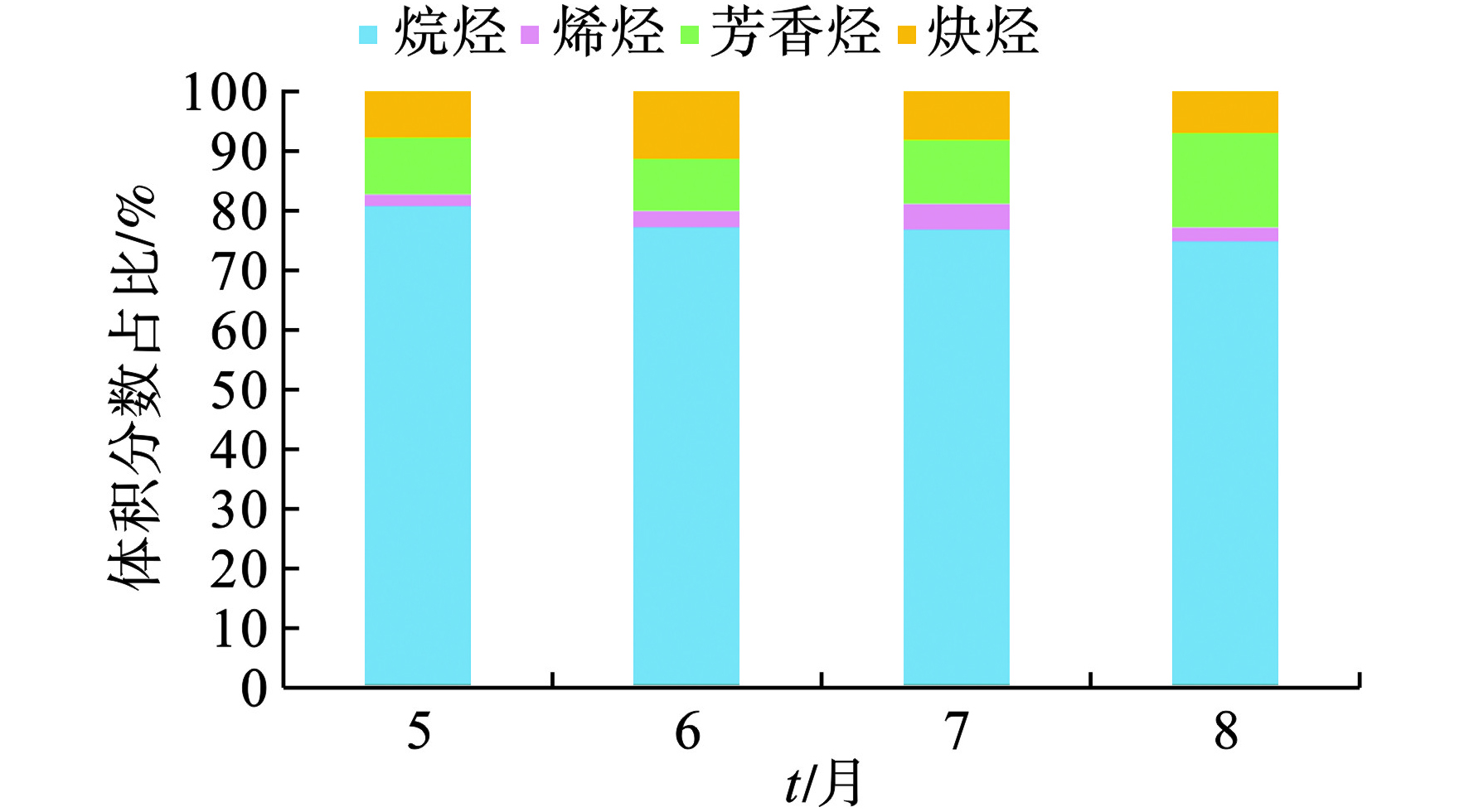
 下载:
下载:
